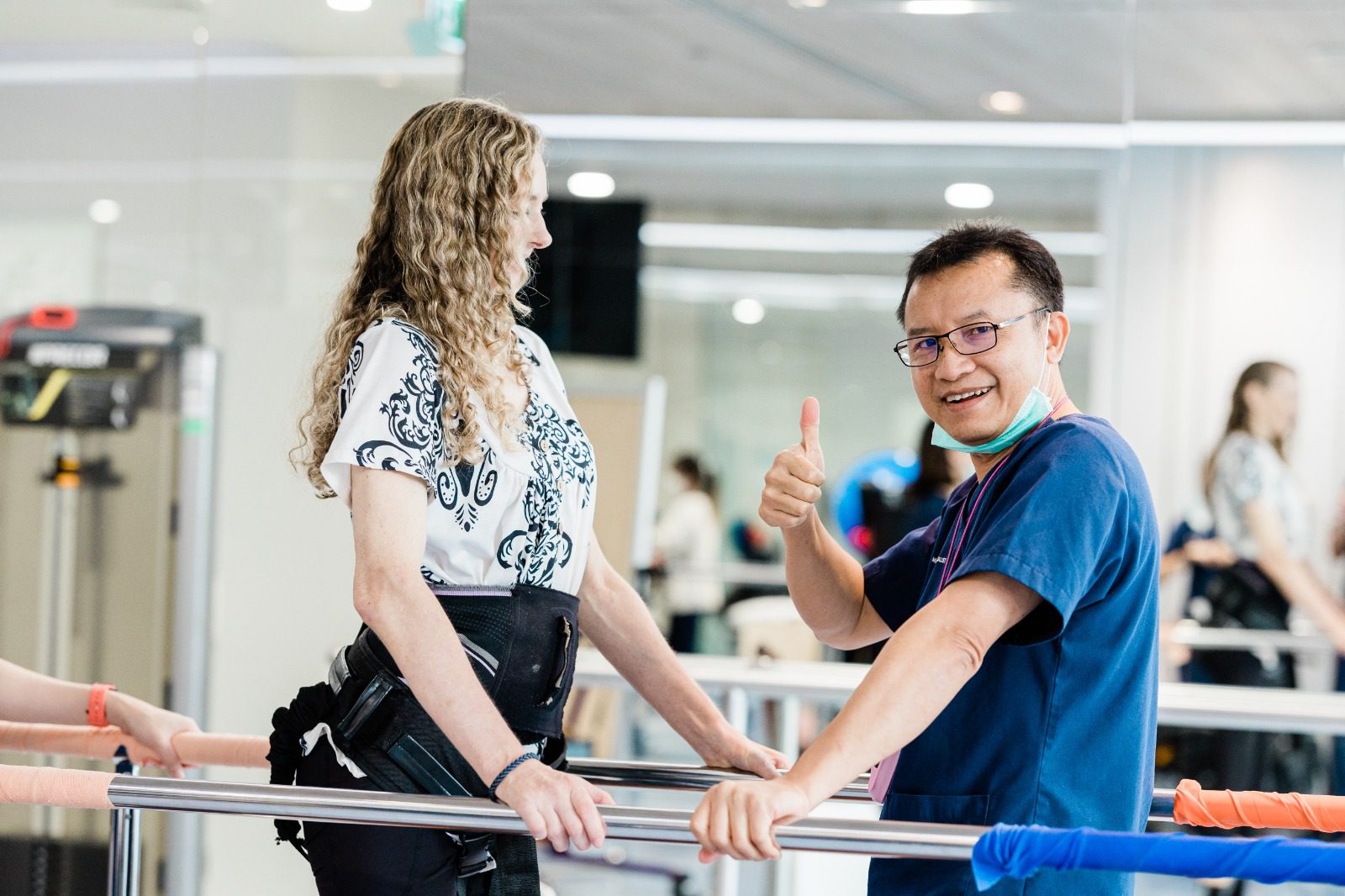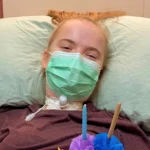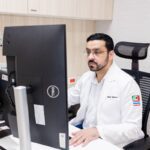Improving patients’ independence after spinal cord injury (SCI) is one of the main priorities for us at Verita Neuro. Epidural stimulation treatment is not a cure for SCI, but it is one of the most sophisticated treatments on the market in terms of improving patient independence and quality of life. Alison first came to Verita Neuro, Thailand in 2022 and since then has made amazing strides to regain a more typical style of life, whilst living with SCI. On her third visit to the clinic, she spoke to us about how her life has changed since her treatment journey began.
Please introduce yourself and tell us about your first visit, maybe the second one as well and your current visit? And maybe you can tell us why you decided to go back for the third time.
Okay, so my name is Alison, and I have C7 spinal cord injury. The first time I came [to Verita Neuro] was at the very end of September 2022. I stayed for a few weeks into November, that’s when I had my operation and the surgery to have the epidural stimulator implanted, and then stayed for the therapy. Then, I came a second time at the end of February, then March for a couple of weeks, for remapping. So that was a little bit soon, I think that normally…I should have waited a little bit longer, but it wasn’t possible for me to come later in the year. This is my third visit. So I came for a couple of weeks, two weeks in December, for the mapping.
How was the experience this time?
Oh, it was really good. Very, very good. I think we saw a lot of improvements. I know that this time, I came and I was able to stand in the parallel bars without any support. So that was the first time I’ve been able to do that, you know, without the therapist, just me standing by myself with my legs holding me and no support behind either. So yeah, that was a big accomplishment. I know I couldn’t do it last time I came, the second visit. But we found a better stepping program, so there were improvements with that, too. So I think overall, it was a really, really good visit. I stood up and was able to stand, you know, in a walker, so okay, with someone holding the walker to stabilize it, but that I was not able to do on the last visit, either. So I think there have been between the second visit and this visit, it was about nine months apart, but I think there were a lot of improvements.
I think in the last interview you mentioned stepping is your favorite exercise. Is it still?
I think so, yes, I think so. But I mean, now I like standing also, that’s probably my next favorite exercise, but I’ll go home and I’ll work on that some more.
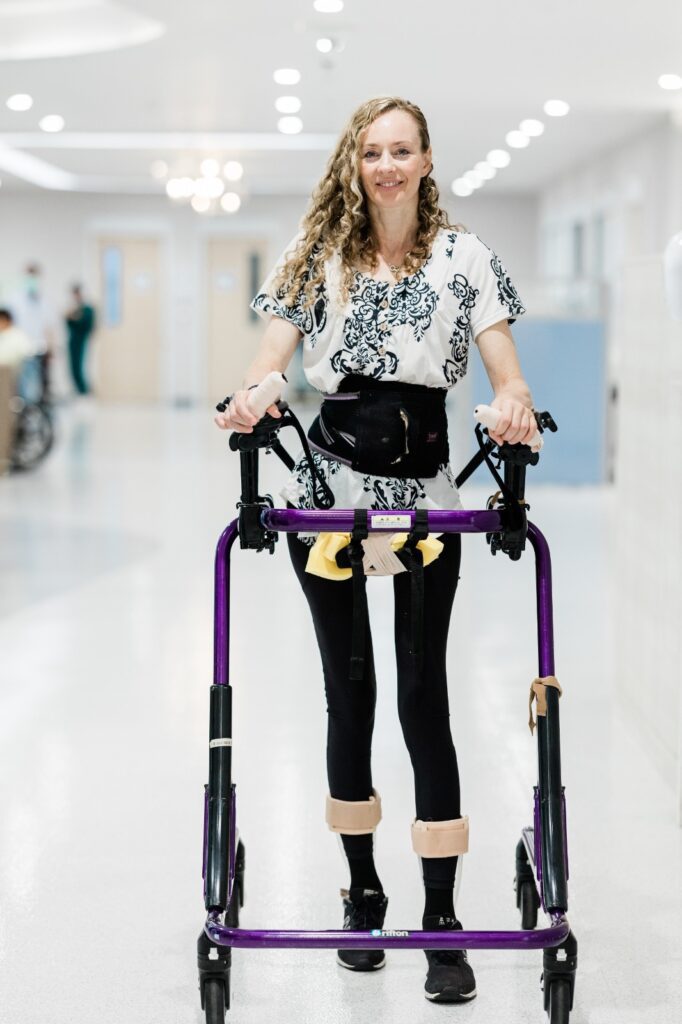
Last time you were here, your top three improvements were movement in your legs, stepping with your left leg and your blood pressure. Have you seen more improvement in these areas, or are there new changes that you are pleased with?
Definitely. I know that this time, I think with the programming of the stimulator, I think that my legs in general were more reactive. So we would find things maybe that they didn’t do before, or different programs. But I think in general, this time around, my legs are more responsive to the programming. So that was really good, too. There was also an improvement with these changes, I think they’re important. The left leg has gotten better, we found, even better than the last time and we found some new programs that work much better. The last time I came, we couldn’t really get my left leg to stand with my full body weight on it and then this time, it did. With my blood pressure, normally, I don’t really have problems with it anymore. So I think that the more – I work with the stimulator a lot at home, you know, three to five hours a day, and I think the more you use it, the better it works, and the more changes you experience over time.
Can you tell us how your rehabilitation has been since returning home?
I mean, I have to do a lot of it myself, because we don’t really have, you know, therapists around us. Or we don’t really have many neuro recovery centers around us. So yeah, I have to do a lot of it by myself but I make time for it and I do several hours a day. I have to think of ways that I can do it by myself or with minimal assistance because my husband can help me a little bit but he doesn’t have the whole day to sit and help me with that. So yeah, with planning, we do it. We have a stable at home, so we have a really long walkway. I think it’s 40 meters or something like that. I have an e-pacer at home as well, I found a used one on eBay, the same one we use here. I just start in the morning and I go, I step, for two hours. Then I try to do the same in the afternoon. Now I have to start standing also, so I’m going to be in the parallel bars. I have to think about it, I’ll structure it.
How has your life at home changed since you had the surgery?
I mean, I feel like I have a lot more I can work with now. For recovery, if your goal is recovery, or to get better, or to get up on your feet, I have a lot more that I can work with now. Before, there wasn’t really much I could do other than, you know, maybe walk with full leg braces and in a special walker. And with that, you don’t really make any progress, but now I have much more I can work with. It feels like there are changes all the time, and it gets better, and there are improvements. So that encourages you to keep going and keeps you motivated.
Because you've been in contact with videos and stuff, I saw how resourceful you are with whatever you have at home. For example, you've been driving your tractor.
Yeah, that’s right, I drove the lawnmower with one of the programs that I had on my control. Yeah, that’s right, so I try to think of “What can I do? How can I use it?” Or “How can I apply it maybe for normal activities?” So yeah, that’s right. I will try to keep thinking now of other things I can do. But yeah, I was driving the lawn mower that you sit on.
And on a horse also! We were wondering how did you get up there?
Oh, well, it was a small pony, a little bit smaller and my husband just picked me up and put me on.
Good family support! So, do you use the trunk program for this?
I did try it a little bit, yeah, I did try the trunk program with it. But, I didn’t use it because, I don’t know, I think that it was making me go more in one direction and it was hard for me to stay centered. But I know that this did get better, because around a year after my injury, I tried sitting in a normal saddle and I was not able to. Even without the program on, I think that this was better.
Speaking of your support system, what do your friends and family members think of your condition since the epidural stimulation?
Oh, they’re really impressed. Yeah, they’re very impressed. Because, now, with the help of the stimulator, I can do things that before were not possible. So I think that they’re all very, very impressed.
Alright! So, how was your remapping experience so far, and how does your day look?
It’s been great. It’s been really, really good and it’s my third time here. Ok, shorter visit, you know, last time I was here for only two weeks. But you know what to expect – I know what to expect a little more. Also, I’ve been using the simulator for a little bit more than a year now, so you have a sense of how it works a little bit better. When they’re remapping, you know, when they’re looking for a new program, or trying new things, you have a better feel of whether it’s working or not, because you can feel the parts of the body that the stimulator is working on. So yeah, I think that it does become easier and you know what to expect.
What have you learned about epidural stimulation between your first treatment and now?
So the first time I came, I never really knew what to expect, and unfortunately, for spinal cord injury, there’s no cure, you know, there really is no cure. This is a treatment, but I think it’s a tool – it’s a tool to get better and the more you use it and work with it, the better the outcome is. So you don’t really know what to expect until you do it and try it.
Do you still feel that epidural stimulation was worth it?
Oh, absolutely. Absolutely. Yeah. Basically, kind of tied to my last response, unfortunately, there is no cure and I think that other than regular physical therapy, which only gets you so far, I think this is one of the only treatment options. So, I’m very happy that I did it and it has brought me forward. I can do things now that I couldn’t do before and there’s a lot of research going on and different kinds of research into spinal cord injury. Something else may work in combination with this and this would only help. That’s a hope that I have for the future. We’ll see!
What do your future plans look like after remapping?
I will go home and work with my new programs and try to think of new exercises that I can do with these programs and then come back again. Hopefully, we’ll see more changes. I know that I want to try to go towards stepping with the walker with less and less support from the seat, so that I get more weight on my feet. I’ll practice standing for longer periods of time and try to build on what we’ve accomplished this visit.
Do you have any messages or words of encouragement?
Spinal cord injury is a very, very hard thing – it’s not an easy injury. But I think that if you have the opportunity or the chance to try it [epidural stimulation] then it’s definitely worth it. I would absolutely do it again. I mean, in retrospect, I wish I had done it a little bit sooner.
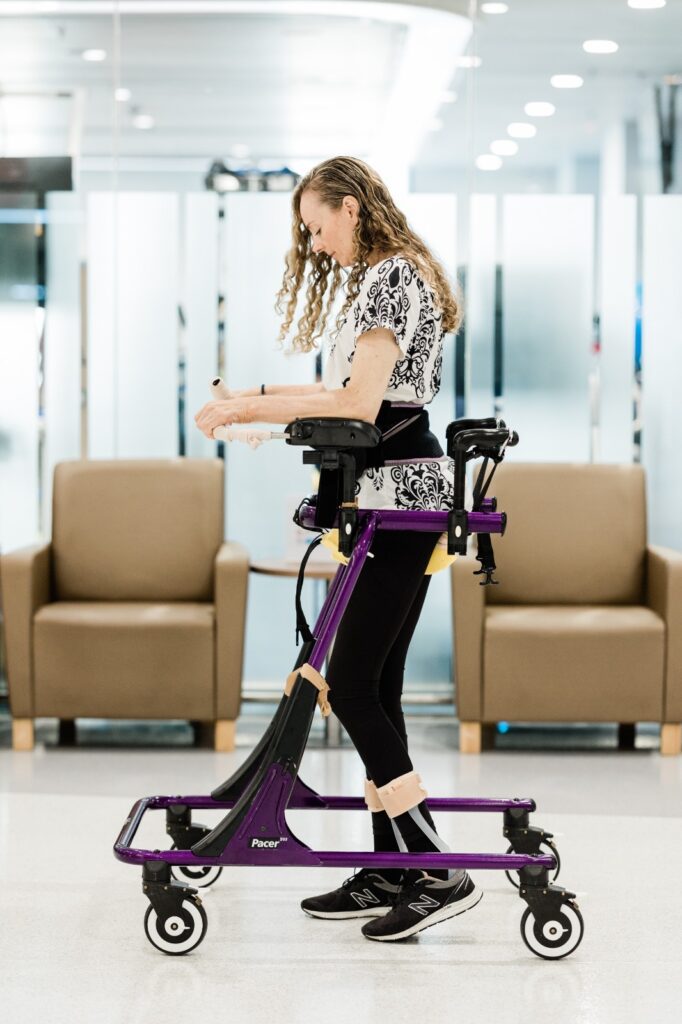
The above is not a verbatim transcript of Alison’s interview. Some comments have been altered or re-arranged in order to improve the reading flow.

